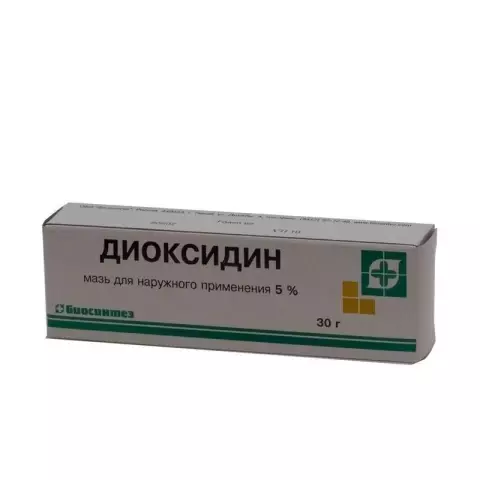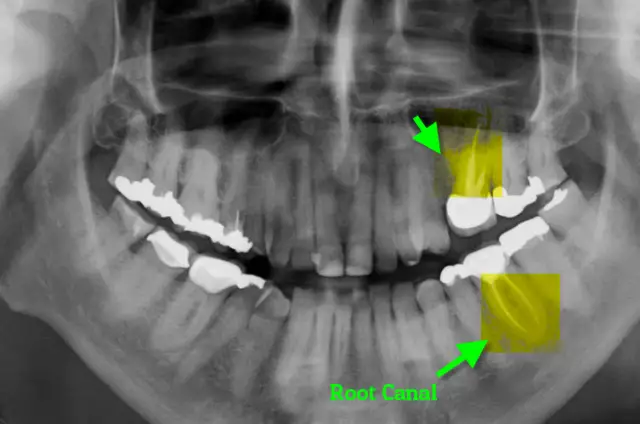- Author Rachel Wainwright [email protected].
- Public 2023-12-15 07:39.
- Last modified 2025-11-02 20:14.
Dioxidine
Instructions for use:
- 1. Pharmacological action
- 2. Release form
- 3. Indications for use
- 4. Contraindications
- 5. Instructions for use
- 6. Side effects
- 7. Storage conditions
Prices in online pharmacies:
from 56 rubles.
Buy

Dioxidine is an antibacterial drug from the group of quinoxaline derivatives. It has a wide spectrum of action, providing an antibacterial, bactericidal effect on various pathogens - staphylococci, Pseudomonas aeruginosa, pathogenic anaerobes, and on some bacterial strains that are resistant to other antibiotics.
pharmachologic effect
The active ingredient is hydroxymethylquinoxaline dioxide. Dioxidin is used in the treatment of various purulent-inflammatory processes caused by Salmonella, Klebsiella, Staphylococcus, Proteus vulgaris, Dysentery bacillus, Pseudomonas aeruginosa, Streptococcus, pathogenic anaerobes. Promotes rapid cleansing and healing of wound surfaces. It also stimulates reparative regeneration. It is widely used in pediatrics in the treatment of rhinitis of various origins.
Release form
The drug Dioxidin is produced in the form of a solution and ointment for external use.
- Dioxidine in ampoules of 0.5% and 1% solution. For local and intracavitary use. 10 ml and 20 ml in an ampoule. 10 pieces per pack;
- Ointment for external use 5%. In tubes of 25 mg, 30 mg, 30 mg, 50 mg, 60 mg, 100 mg.
Indications for the use of Dioxidin
Dioxidine is used in the treatment of purulent diseases caused by various bacterial infections.
Outwardly used for:
- Infected with burns;
- Non-healing wounds and trophic ulcers, as well as for the healing of deep and superficial wounds of various localization;
- Phlegmon of soft tissues;
- Purulent wounds with osteomyelitis.
Intracavitary administration of Dioxidine in ampoules is used for:
- Purulent processes in the chest and abdominal cavity;
- Lung abscesses;
- Peritonitis;
- With purulent pleurisy and pleural empyema;
- Cystitis;
- Wounds with deep purulent cavities. It can be phlegmon of pelvic tissue, soft tissue abscesses, purulent mastitis, postoperative wounds of the urinary and biliary tract.
Contraindications
According to the instructions, dioxidine is contraindicated in case of hypersensitivity to the active substance - hydroxymethylquinoxalindioxide, and in adrenal insufficiency.
The drug is not used during pregnancy and lactation, as well as in childhood.
With caution, according to the instructions, Dioxidin is prescribed for renal failure. If necessary, the dose of the drug can be reduced.
In pediatrics, nasal drops with Dioxidin are often used in the treatment of rhinitis and sinusitis. As an antibiotic, the drug successfully treats these diseases of almost any origin, providing anti-inflammatory, anti-allergic and anti-edema effects. For the use of Dioxidin in the nose, a 0.5% solution of the drug is used and instilled into each nostril 4-5 times. Before use, you must consult an ENT doctor.
Instructions for the use of Dioxidin
Most often, Dioxidine is used in stationary conditions. A 1% solution of the drug is usually not used for intravenous injections (due to the instability of the drug when stored at low temperatures). Apply 0.1-1% solutions, for which the drug is diluted with water for injection or sodium chloride solution.
External use of Dioxidine:
- For the treatment of deep purulent wounds with osteomyelitis - in the form of baths with a 0.5-1% solution. Less often, a special wound treatment is carried out with the introduction of the drug for 15-20 minutes, then a bandage is applied with a 1% solution of Dioxidin. If the drug is well tolerated, treatment can be carried out daily for 1.5-2 months;
- In the treatment of superficial infected purulent wounds, napkins soaked in 0.5-1% Dioxidine solution are applied to the wound. When treating deep wounds, they are loosely tamponed with tampons pre-moistened in a 1% solution. In the presence of a drainage tube, a 0.5% solution is injected into the cavity, from 20 to 100 ml;
- For the prevention of infections after surgery, Dioxidin is used in the form of a 0.1-0.5% solution.

For intracavitary administration, a catheter, syringe, or drainage tube is used. A 1% solution of the drug is injected into the purulent cavity, the dose depends on the size of the cavity, usually 10-15 ml per day. Usually the drug is administered once a day. The maximum daily dose is 70 ml. Treatment can be continued for three weeks or more if indicated and well tolerated.
Side effects
With intracavitary Dioxidine administration, the following may occur:
- Temperature increase;
- Chills;
- Headache;
- Convulsive muscle contractions;
- Vomiting or nausea;
- Allergic reactions.
When applied externally, peri-wound dermatitis may develop.
Also, sometimes when using Dioxidine, age spots may appear on the skin. In these cases, the time of administration of a single dose is increased, the dose of the drug is reduced, and antiallergic drugs are prescribed. In cases where this prophylaxis does not work, the drug is canceled.
Treatment with Dioxidin begins after a tolerance test - in the absence of side effects within 3-6 hours after injection of 10 ml of a 1% solution into the cavity.
Dioxidine is prescribed when other antibacterial drugs (carbapenems, II-IV generations cephalosporins or fluoroquinolones) are ineffective.
Storage conditions
Dioxidine is available by prescription. Shelf life is 2 years. Store at temperatures between 18 ° and 25 ° C. If crystals of the active substance fall out during storage of the drug, the ampoules are heated in a water bath and shaken until completely dissolved. If during cooling to 36-38 ° C crystals do not fall out, then the drug can be used.
Dioxidin: prices in online pharmacies
|
Drug name Price Pharmacy |
|
Dioxidine 5 mg / ml solution for infusion and external use 5 ml 10 pcs. RUB 56 Buy |
|
Dioxidine 1% solution for intracavitary administration and external use 5 ml 10 pcs. RUB 62 Buy |
|
Dioxidine 5% ointment for external use 30 g 1 pc. 242 r Buy |
|
Dioxidine 5% ointment for external use 30 g 1 pc. RUB 380 Buy |
|
Dioxidine ointment 5% 30g 424 r Buy |
|
Dioxidin 1% solution for intracavitary administration and external use 10 ml 10 pcs. 450 RUB Buy |
|
Dioxidine 10 mg / ml solution for intracavitary administration and external use 10 ml 10 pcs. 460 RUB Buy |
|
Dioxidine 5 mg / ml solution for infusion and external use 10 ml 10 pcs. RUB 481 Buy |
|
Dioxidine solution for intravenous injection and local approx. 0.5% 10ml 10 pcs. 486 r Buy |
|
Dioxidine solution for intravenous injection and local approx. 0.5% 5ml 10 pcs. 498 r Buy |
|
Dioxidine solution in / p and outside. approx. 1% 5ml 10 pcs. RUB 520 Buy |
|
Dioxidine 5 mg / ml solution for intravenous administration of local and external use 10 ml 10 pcs. RUB 530 Buy |
|
Dioxidine solution in / p and outside. approx. 1% 10ml 10 pcs. RUB 539 Buy |
|
Voskopran atraumatic dressing with Dioxidin ointment 5% 7.5 x 5 cm Dressing with Dioxidin 5% ointment 5 pcs. 558 r Buy |
|
Dioxidine 5 mg / ml solution for intravenous administration 10 ml 10 pcs. 750 RUB Buy |
|
Dioxidin 1% solution for intracavitary administration and external use 10 ml 10 pcs. 966 RUB Buy |
| See all offers from pharmacies |
Information about the drug is generalized, provided for informational purposes only and does not replace the official instructions. Self-medication is hazardous to health!






